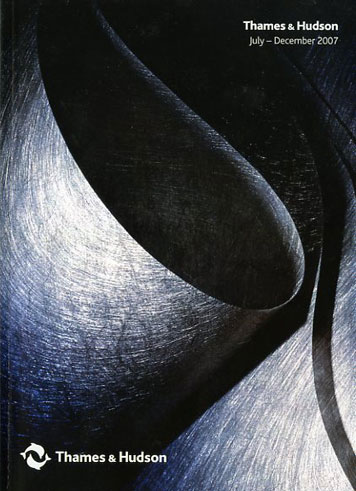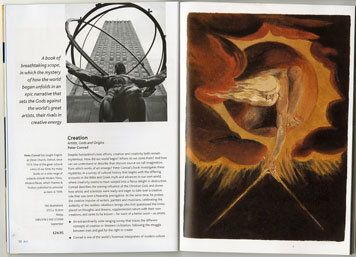
Thames & Hudson catalog cover, Fall 2007.
I read publishers' seasonal catalogs the way some people go to the movies, in part to watch the trailers for coming attractions. You get the gist — if not the best parts — but don't necessarily have to see the film. Likewise, from catalogs I glean what's up-and-coming, but I don't necessarily have to buy the book. Or conversely, after seeing what's not yet in the stores, I have something special to look forward to — another reason to live.
Book catalogs are considerably more elaborate lately — full-color object photographs of books are alluring (and the covers and jackets look better in miniature anyway, especially with drop shadows). A few, like the Taschen bi-annual magazine/catalog, even include excerpts and other exclusive editorial content; so as not to be simply sales pitches but proxy cultural experiences. It's like receiving the New York Review of Books but without the pressure of having to read the long essays, or the guilt of not doing so.
Most publishers issue catalogs twice a year (some three times), so it is around early to mid-summer that Fall and Winter offerings come through the mails. When I was art director of The New York Times Book Review I looked forward to the en masse arrival, and while I'm not at that job any longer, I'm still on a few choice mailing lists.
Yesterday the Thames and Hudson U.K. catalog arrived and after ripping off the plastic, I found my groove on the couch and started to peruse its glossy pages. I'm not just singling out T&H because (full disclosure) I have a new book in this catalog, but because I truly enjoy scanning the coming attractions and reading the florid promotion copy — and florid it often is, even to the point of making me wince — but that's a large part of the experience.
In fact, the only problem with book catalogs these days is that some tend to read like computer software mail-order circulars. The book business is just so competitive, and so few books actually make big bucks, that hard sell has become de rigeur. Decades ago, promotion for books was itself a literary art — much of it written either by wannabe novelists or interns from Smith and Sarah Lawrence colleges.
Nonetheless, what I particularly like about the T&H catalog is that it is laid out in a small-journal format, featuring twenty-one categories, from "Art" to "Children" (obviously not in alphabetical order, but rather based on what the T&H sales force sells the most). It also includes sections on "Product Design," "Visual Communication" (i.e. graphic design) and "Popular Culture" (the catchall for all manner of weird and wonderful things).
I'm always anxious to see what other authors have done in my field, although it can be depressing when I find that a book I'd been working on, or dreaming about doing, is already on the list before mine is finished or even started. It has happened more than once, but this season I'm free and clear — at least with T&H. Still, in this catalog I admit to being rather green-eyed over quite a few books I would have wanted to do.

Thames & Hudson catalog art-section spread, Fall 2007.
The first in this category is Creation: Artists, Gods and Origins by Peter Conrad, about all the major and minor art ever produced featuring deities — or as the catalog copy intones: "A book of breathtaking scope in which the mystery of how the world began unfolds in an epic narrative that sets the Gods against the world's great artists, their rivals in creative energy." How can you not be inspired? A few pages later I was struck by The Society Portrait: Painting, Prestige and the Pursuit of Elegance by Gabriel Badea-Päun, which surveys "a dazzling array of works of art" from David to Warhol, "a lesson in elegance, grace, and style." Yummmy.
Jumping to "Textiles" there is a global survey of trends and traditions, and a world guide of quilting, patchwork and appliqué (you might knot know it but I live for appliqué). Under "Decorative Arts" is a history of the shell as decoration and ornament (a long time in coming, I'd say) and The Majesty of Mughal Decoration ("an essential reference work for art historians, designers and anyone interested in the arts and life of India"). In "Architecture" is offered a "vibrant, quirky survey of the finest examples of parking garages," called The Architecture of Parking (and at under $40 it costs less than my monthly garage payments).
Moving on to "History" I'm simply yearning for The Story of Measurement by Andrew Robinson (who would have thought that "the first fully illustrated guide to the human passion for measurement — of ourselves, our experiences and our surroundings" would be so fully illustrated?). In the "Food" section I can't wait for Food: The History of Taste ("The perfect foodie's gift for Christmas 2007"). And in "Travel & Transport," an area I've never been too keen on because I hate to travel and am not found of transport, I was nonetheless smitten by How to Fly a Plane by Nick Barnard ("Get airborne with the aid of this lavishly illustrated guide to flying"). Sign me up.
Then there's "Visual Communication" with entries on the following tantalizing themes: "the ultimate book on signage in all its different forms, packed with real-life examples from around the world," "AGI's who's who of the world of international graphic design" and "the bible of street culture, in the same format as Graffiti World." But the two I most envy are Vietnam Zippos by Sherry Buchanan, which showcases for the first time the "personalized Zippo [lighter] engravings by American soldiers during the Vietnam War (1964-1973)" and War Posters: Weapons of Mass Communication by James Aulich, "a mesmerizing collection of hard-hitting propaganda and groundbreaking graphic design."
Other than browsing a bookstore's shelves, there's probably nothing better for this bookophile than browsing publisher's catalogs — if only the books themselves took up as little space.
